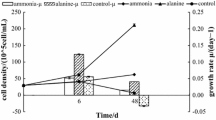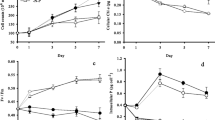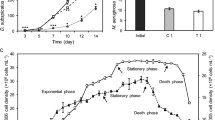Abstract
Hepatotoxin production in cyanobacteria has been shown to correlate to external stimuli such as light and nutrient concentrations and ratios, although conflicting results have been reported. Specific growth rates and protein and microcystin content of M. aeruginosa PCC7806 and M. aeruginosa UV027 were determined under nonlimiting batch culture conditions for a range of medium nitrogen and phosphorous atomic ratios. Both strains exhibited a similar optimal medium N:P ratio for increased cellular microcystin levels. Additionally, total cellular protein content and intracellular microcystin content were significantly correlated to each other (r2 = 0.81, p < 0.001). Microcystin and protein content increased considerably as the maximum specific growth rate for the experimental conditions was reached. The significant correlation of cellular protein and microcystin content and their relative increase with increasing specific growth rate, within defined ranges of medium N:P ratios, suggest a close association between microcystin production and N:P ratio–dependent assimilation of nitrogen, and resulting total cellular protein levels, which may be further modulated by specific growth rate.



Similar content being viewed by others
References
C Ash C MacKintosh R Mackintosh CR Fricker (1995) ArticleTitleUse of a protein phosphatase inhibition test for the detection of cyanobacterial toxins in water Wat Sci Technol 31 51–53
K Benschneider RJ Robinson (1952) ArticleTitleA new spectrophotometric method for the detection of nitrate in seawater J Mar Res 11 87–96
WW Carmichael (1994) ArticleTitleThe toxins of cyanobacteria Sci Am 270 78–86
GA Codd GK Poon (1988) Cyanobacterial toxins LJ Rogers JR Gallon (Eds) Biochemistry of the Algae and Cyanobacteria Clarendon Press Oxford 283–296
MR Droop (1973) ArticleTitleSome thoughts on nutrient limitation in algae J Phycol 9 264–272
JE Eriksson L Gronberg S Nygard JP Slotte JAO Meriluoto (1990) ArticleTitleHepatocellular uptake of 3H-dihydromicrocystin-LR, a cyclic peptide toxin Biochim Biophys Acta 1025 60–66
Q Hu P Westerhoff WJM Vermaas (2000) ArticleTitleRemoval of nitrate from groundwater by cyanobacteria: quantitative assessment of factors influencing nitrate uptake Appl Env Microbiol 66 133–139
M Kaebernick BA Neilan T Boerner E Dittmann (2000) ArticleTitleLight and the transcriptional response of the microcystin biosynthetic gene cluster Appl Environ Microbiol 66 3387–3392
M Kaebernick BA Neilan (2001) ArticleTitleEcological and molecular investigations of cyanotoxin production FEMS Microbiol Ecol 35 1–9
BG Kotak K-Y Lam EE Prepas SL Kenefick SE Hrudey (1995) ArticleTitleVariability of the hepatotoxin microcystin-LR in hypereutrophic drinking water lakes J Phycol 31 248–263
L Lawton B Marsalek J Padisák I Chorus (1999) Cyanobacterial toxins I Chorus J Bartram (Eds) Toxic Cyanobacteria in Water—A Guide to Their Public Health Consequences and Management E & F Spon London 347–367
H-M Lee MF Vasques-Bermudez NT Tandeau Marsac Particlede (1999) ArticleTitleThe global regulator NtcA regulates transcription of the signal transducer PII (GlnB) and influences its phosphorylation level in Synechococcus sp. Strain PCC7942 J Bacteriol 181 2697–2702
SJ Lee M-H Jang H-S Kim B-D Yoon H-M Oh (2000) ArticleTitleVariation in microcystin content of Microcystis aeruginosa relative to medium N:P ratio and growth stage J Appl Microbiol 89 323–329
BM Long GJ Jones PT Orr (2001) ArticleTitleCellular microcystin content in N-limited Microcystis aeruginosa can be predicted from growth rate Appl Environ Microbiol 67 278–283
C MacKintosh KA Beattie S Klump P Cohen GA Codd (1990) ArticleTitleCyanobacterial microcystin-LR is a potent and specific inhibitor of protein phosphatases 1 and 2A from both mammals and higher plants FEBS Lett 264 187–192
J Murphy JP Riley (1962) ArticleTitleA modified single solution method for the determination of phosphate in natural waters Anal Chim Acta 27 31–36
H-M Oh SJ Lee M-H Jang B-D Yoon (2000) ArticleTitleMicrocystin production by Microcystis aeruginosa in a phosphorus-limited chemostat Appl Environ Microbiol 66 176–179
PT Orr GJ Jones (1998) ArticleTitleRelationship between microcystin production and cell division rates in nitrogen-limited Microcystis aeruginosa cultures Limnol Oceanogr 43 1604–1614
R Rippka (1998) ArticleTitleRecognition and identification of cyanobacteria Methods Enzymol 167 28–67
K Sivonen (1996) ArticleTitleCyanobacterial toxins and toxin production Phycologia 35 12–24
K Sivonen GJ Jones (1999) Cyanobacterial toxins I Chorus J Bartram (Eds) Toxic Cyanobacteria in Water — A Guide to Their Public Health Consequences and Management E & F Spon London 41–111
PK Smith RI Krohn GT Hermanson AK Mallia FH Gartner MD Provenzano EK Fujimoto NM Goeke BJ Olsen DC Klenk (1985) ArticleTitleMeasurement of protein using bicinchoninic acid Anal Biochem 150 76–85
H Utkilen N Gjølme (1992) ArticleTitleToxin production by Microcystis aeruginosa as a function of light in continuous cultures and its ecological significance Appl Environ Microbiol 58 1321–1325
H Utkilen N Gjølme (1995) ArticleTitleIron-stimulated toxin production by Microcystis aeruginosa Appl Environ Microbiol 61 797–800
AJ Westhuizen ParticleVan der JN Eloff (1985) ArticleTitleThe effect of temperature and light on toxicity of and growth of the blue-green alga Microcystis aeruginosa (UV-006) Planta 163 55–59
CJ Ward A Beattie EYC Lee GA Codd (1997) ArticleTitleColorimetric protein phosophatase inhibition assay of laboratory strains and natural blooms of cyanobacterial comparisons with high-performance liquid chromatography analysis for microcystins FEMS Lett 153 465–473
MF Watanabe S Oishi (1985) ArticleTitleEffects of environmental factors on toxicity of cyanobacterium (Microcystis aeruginosa) under culture conditions Appl Environ Microbiol 49 1342–1344
MF Watanabe K-I Hrada K Matsuura M Watanabe M Suzuki (1989) ArticleTitleHeptapeptide toxin production during the batch culture of two Microcystis species (cyanobacteria) J Appl Phycol 1 161–165
RJ Wicks PG Thiel (1990) ArticleTitleEnvironmental factors affecting the production of peptide toxins in floating scums of the cyanobacterium Microcystis aeruginosa in a hypertrophic African reservoir Environ Sci Technol 24 1413–1418
Acknowledgments
This work was supported by grant K5/1401 from the Water Research Commission of South Africa.
Author information
Authors and Affiliations
Corresponding author
Rights and permissions
About this article
Cite this article
Downing, T., Sember, C., Gehringer, M. et al. Medium N:P Ratios and Specific Growth Rate ComodulateMicrocystin and Protein Content in Microcystis aeruginosa PCC7806 and M. aeruginosa UV027. Microb Ecol 49, 468–473 (2005). https://doi.org/10.1007/s00248-004-0054-2
Received:
Accepted:
Published:
Issue Date:
DOI: https://doi.org/10.1007/s00248-004-0054-2




